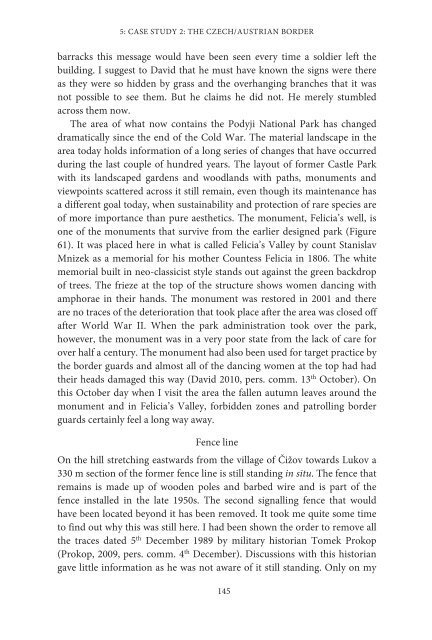1JZGauQ
1JZGauQ
1JZGauQ
You also want an ePaper? Increase the reach of your titles
YUMPU automatically turns print PDFs into web optimized ePapers that Google loves.
5: CASE STUDY 2: THE CZECH/AUSTRIAN BORDER<br />
barracks this message would have been seen every time a soldier left the<br />
building. I suggest to David that he must have known the signs were there<br />
as they were so hidden by grass and the overhanging branches that it was<br />
not possible to see them. But he claims he did not. He merely stumbled<br />
across them now.<br />
The area of what now contains the Podyji National Park has changed<br />
dramatically since the end of the Cold War. The material landscape in the<br />
area today holds information of a long series of changes that have occurred<br />
during the last couple of hundred years. The layout of former Castle Park<br />
with its landscaped gardens and woodlands with paths, monuments and<br />
viewpoints scattered across it still remain, even though its maintenance has<br />
a different goal today, when sustainability and protection of rare species are<br />
of more importance than pure aesthetics. The monument, Felicia’s well, is<br />
one of the monuments that survive from the earlier designed park (Figure<br />
61). It was placed here in what is called Felicia’s Valley by count Stanislav<br />
Mnizek as a memorial for his mother Countess Felicia in 1806. The white<br />
memorial built in neo-classicist style stands out against the green backdrop<br />
of trees. The frieze at the top of the structure shows women dancing with<br />
amphorae in their hands. The monument was restored in 2001 and there<br />
are no traces of the deterioration that took place after the area was closed off<br />
after World War II. When the park administration took over the park,<br />
however, the monument was in a very poor state from the lack of care for<br />
over half a century. The monument had also been used for target practice by<br />
the border guards and almost all of the dancing women at the top had had<br />
their heads damaged this way (David 2010, pers. comm. 13 th October). On<br />
this October day when I visit the area the fallen autumn leaves around the<br />
monument and in Felicia’s Valley, forbidden zones and patrolling border<br />
guards certainly feel a long way away.<br />
Fence line<br />
On the hill stretching eastwards from the village of Čižov towards Lukov a<br />
330 m section of the former fence line is still standing in situ. The fence that<br />
remains is made up of wooden poles and barbed wire and is part of the<br />
fence installed in the late 1950s. The second signalling fence that would<br />
have been located beyond it has been removed. It took me quite some time<br />
to find out why this was still here. I had been shown the order to remove all<br />
the traces dated 5 th December 1989 by military historian Tomek Prokop<br />
(Prokop, 2009, pers. comm. 4 th December). Discussions with this historian<br />
gave little information as he was not aware of it still standing. Only on my<br />
145




